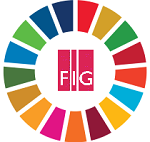News in 2022

|
FIG and the Sustainable Development Goals - Commission 8
June 2022
FIG Task Force on FIG and the Sustainable Development Goals together
with the ten Commissions have worked on their role on the sustainable
development goals relevant for their Commission.
Commission Chair Marije Louwsma gives her Statement on the
sustainable development goals in relation to Commission 8 -
Spatial Planning and Development
|
 |
Commission 8 focuses on a sustainable spatial development through a
spatially balanced land use. A long-term focus contributes to finding
pathways for development that meet the needs of the present without
compromising the ability of the future (Brundtland commission, 1987).
Facing the impact of climate change, this definition of sustainability
is challenged. Is it still possible to make sustainable choices not
compromising the needs of both current and future generations?
Contemporary challenges urge land use planners, surveyors and
politicians to make difficult choices regarding the spatial distribution
of activities and land uses in view of the Sustainable Development Goals
(SDG’s).
Which SDG is most relevant for spatial planning and development?
Spatial planning deals with different sectors and disciplines on the
way to sustainable spatial developments. That makes that multiple SDG’s
are related to the work of FIG’s commission 8. Optimising land use from
a spatial perspective contributes to several SDG’s such as food security
(zero hunger), no poverty (e.g. control over land), gender equality
(e.g. equal access to land and other resources), sustainable cities and
communities, climate action and life on land.
Although climate change is on the radar for a considerable time
already, nowadays its impact becomes apparent in all its forms (drought,
flooding, cyclones, sea level rise, melting glaciers etc.) around the
globe. It is time to act and prevent further pollution in a fair and
sustainable way. The impact of the most polluting countries and regions
is felt far beyond their territory. Actions to further reduce pollution
and emissions should be taken (mitigation), just like actions to adapt
land use to minimize the negative impact of climate change (adaptation).
Both mitigation and adaptation are important pillars for a sustainable
approach in spatial planning. Therefore, cooperation among stakeholders
and involved authorities is needed at various governance levels (local,
national and supranational). The voice of the vulnerable and those
living and working on the land should be heard in this regard.
How to integrate the SDG's in spatial planning and development?
Spatial planning looks at the spatial arrangement or distribution of
land, people and functions (land use). It can be subdivided in different
layers; the natural physical layer (e.g. geology, soil, water), the
network layer, and the occupation or land use layer. Key to a
sustainable development is balancing the various interests and relate
these to the situation and social, economic and environmental context.
This is not an easy task, as developments in one sector might have a
negative impact on other sectors. Mining resources for batteries, solar
panels and the like, negatively impacts the society and environment at
the local level but batteries contribute to the transition to renewable
energy. All in all, it is very important to have transparent and
inclusive decision-making processes where all aspects and interests are
well-balanced. Surveyors can provide decision-makers and those involved
in participatory planning processes with the needed information to
discuss expected future developments, directions for development and
possible solutions regarding the spatial arrangement of land use. Yet,
it is acknowledged that any spatial planning process has to face
insecurities about expected future developments irrespective how much
data is at hand.
How the FIG commissions work to advance the achievement of the
SDGs
Fostering the exchange of knowledge among experts in spatial planning
and related fields is an important pillar of commission 8 its work
within FIG. Since climate change is an overarching phenomenon,
transcending administrative borders, it is key to work together and find
the best way forward. Food security, production of goods, services,
transportation networks can all be addressed at several levels, from the
local to national to global. FIG is an important network to address the
supra national level yet taking into account the geographic variations
across regions.
Naturally, the annual Working Weeks / Congress and commission 8
meetings contribute to the exchange of knowledge among countries,
regions and continents, among practitioners and academia, among
governments and industry, and among disciplines. These are the occasions
where peers meet, build relations and exchange knowledge and experiences
that are brought home again for inspiration and further development.
Some members of this professional network joined forces and decided
to bundle their knowledge into a FIG publication. In the term 2019 –
2022, commission 8 has published three FIG reports: one on water
governance in Africa, one on land consolidation and a joint one with
commission 3 on the role of geospatial data. Authors from FIG
Commissions 3 and 8, the FIG Young Surveyors Network, and the Volunteer
Community Surveyor Program contributed to the latter publication titled
'Geospatial Data in the 2020s - transformative power and pathways to
sustainability’. The publication highlights the impact of geospatial
data for spatial planning, health, diversity, volunteerism, cadastre,
and the property market in the 2020s. It was officially launched at the
FIG Congress 2022 in Warsaw, Poland. All reports relate one way or the
other to the SDG’s and to sustainability in particular.
Above mentioned examples indicate the benefits for the FIG network
and its members and highlight the role of FIG and commission 8 in view
of a better – more sustainable - world. The SDG’s encompass a diverse
range of aspects of sustainability. As such it provides guidance for
themes and topics to focus on through the lens of a spatial planner and
surveyor.
Marije Louwsma and Paula Dijkstra
December 2022































